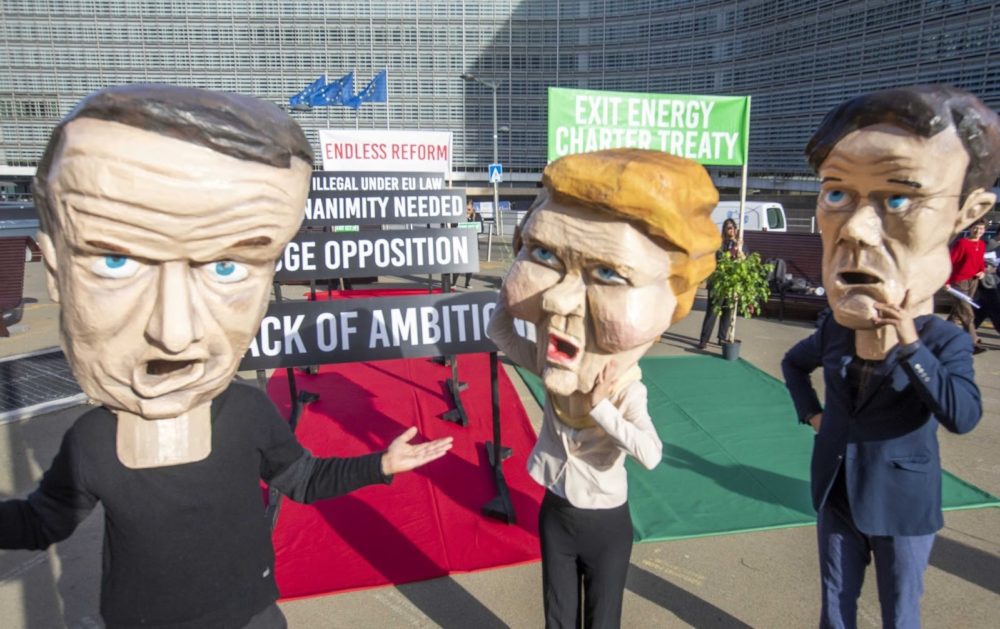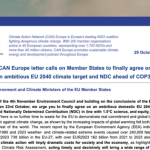While countries in Europe and the EU are stepping up their climate action with more ambitious policies, there is a treaty which provides legal protections for investments in fossil fuels. The Energy Charter Treaty (ECT) is a little known but highly controversial international trade and investment agreement which is a major blocker to climate action and gives fossil fuel companies the power to sue sovereign governments over their climate policies. Through a mechanism called Investor State Dispute Settlement (ISDS) companies which invest in energy products and infrastructure such as coal mines, oil fields and gas pipelines can sue any of the 55 signatories (including the EU, Germany, France & UK) that have signed the Treaty if their actions harm profits. It is a system which lacks transparency, is highly favourable to investors and does nothing to help facilitate our transition to a low carbon world.
The ECT’s investment protection provisions were designed in a bygone era and the protection of fossil fuels contradicts the groundbreaking Paris agreement, which all of the Treaty’s members have signed. In view of this situation the European Commission has called the Treaty “outdated” and “no longer sustainable”. Parliamentarians and civil society organisations from across Europe have called on EU Member States to jointly withdraw from the Treaty.
Rather than exit the ECT and take the quickest route to freedom from the regulatory strait jacket that the Treaty puts its members in, the EU has instead embarked on a reform agenda designed to align the Treaty with modern investment protection standards and the Paris agreement. This Monday, the latest round of negotiations on these changes will take place and signatories to the Treaty will meet for their annual meeting to take stock of progress on the year’s objectives. We have done our own stock-taking exercise and here we have set out eight reasons why we believe this process is doomed to fail.

-
There is no case for why ECT is needed in the first place
Reformed or not the ECT is outdated, inappropriate and may not even provide the uplift in foreign direct investment that some countries believe it will. According to OECD research there is no evidence that the favourable protection of foreign investment – which brings with it massive risks – produces a significant benefit for countries that sign up to it. In this context the case for whether the ECT is needed at all looks very weak.
Apart from investment protection, the Treaty contains rules for trade and transit of energy and energy materials. A recent legal study commissioned by the Chamber of Labour in Vienna looked at these provisions and found that they are largely replicated by the World Trade Organisation (WTO) rules, which most ECT members are also members of.
If it is unable to address the fundamental question of why the ECT is needed at all then the reform process is little more than an exercise in protecting business as usual. What we need is a completely new way of doing things to ensure the bold transformation that can keep the 1.5 degree goal in reach.
-
The reform won’t end investment protection for fossil fuels
The EU’s modernisation proposals would continue to protect existing fossil fuel investments for a period of ten years after the ratification of reforms. That means that fossil infrastructure like coal fired power stations would be protected until at least the mid 2030s, and some fossil gas infrastructure right up to 2040. The science tells us that we need to be well on the way to net-zero already by 2030 if we want to keep a 1.5 degree world alive – so these proposals just don’t cut it.
The Glasgow Climate Pact signed at COP26 commits all countries to make their 2030 emissions targets more ambitious. This requires a massive scaleback in coal, gas and oil but with fossil fuels legally protected under the ECT beyond this date, that pledge is at risk before the ink is barely dry. The policies which will determine the success of our global efforts to decarbonise are being made now. To prevent corporate investors from attacking the fossil fuel phase out, we need to end their investment protection today, not in ten to twenty years time.
We also know that there is a proposal on the table to introduce ‘flexibility’ into the definitions of fossil fuel investments that are protected under the ECT. This would mean that some countries could continue to provide legal protections for fossil fuels for even longer than 10 years. This is a serious concern because it means that the ECT could continue to give fossil fuel companies the right to sue over climate action indefinitely.
-
The reform could make the ECT even more dangerous
There are certain technologies and energy carriers that are currently not protected under the ECT. The EU and other ECT contracting parties want to change this and for instance include hydrogen and biomass in the list of energy technologies that are protected under the ECT – a move which would expand the risk of ISDS challenges even further.
The ECT’s investment protection provisions are very broad and go beyond what is provided by European or national law. In the past, this has often led to compensation claims against legitimate policy measures to protect people and the environment. But the energy transition requires states to intervene, both to phase out fossil fuels and to create a healthy policy environment for the renewable energy sector to blossom.
Any expansion of the ECT to new technologies would significantly increase the risk of Investor State Dispute Settlement (ISDS) cases. For instance, the EU envisages a significant investment in hydrogen as part of the energy transition. Any future state actions that impact the profitability of hydrogen plants, raise sustainability standards or make changes to subsidies could be targeted with expensive lawsuits.
For bioenergy there is also a risk of new ISDS claims. The Commission has already committed to assess the sustainability of biomass. The implementation of such measures could be challenged under the ECT. Moreover, EU member states and the UK are paying out over €6.5 billion in subsidies per year to biomass burning facilities. Changes to these subsidy schemes could trigger ISDS claims too.
With all new technologies, governments need more regulatory space, not less, in order to manage unforeseen consequences, adjust incentive schemes and steer investment to where it is needed. Placing hydrogen and biomass under the jurisdiction of the ECT would constrain governments, just at a time when they need to be nimble and innovative in the fight against climate catastrophe. Far from improving the green credentials of the ECT, the inclusion of hydrogen, biomass and other technologies could increase exposure to risk of legal challenge and could make this Treaty even more dangerous.
-
Key elements are missing – dispute settlement not even on the agenda
One of the most significant problems with the ECT is the way that disputes are resolved when parties make a claim against a government. The ECT uses ISDS which creates a parallel legal system for foreign investors. In ISDS, private arbitration panels decide about the outcomes, not independent judges. There is no appeals mechanism either so the decision of the panel is final. These panels consist of investment lawyers who are paid on a case-by-case basis which incentivises them to inflate the number of cases they can work on. This investor-favourable context could explain the apparent bias against states in ISDS cases.
ISDS is highly controversial and many countries, as well as the EU, have stopped including this system in recently signed trade deals. Despite the controversy around ISDS, the ECT’s dispute mechanism is not even one of the 25 topics for the reform and any new topics added to the agenda must be approved unanimously by all contracting parties. When the EU suggested that it be included in the negotiations, other countries objected. The fact that the EU has not been able to persuade the other members of the Treaty to even talk about this topic means that claims made under the ECT for the foreseeable future will be overseen by the same for-profit arbitrators under a system which is skewed towards investors.
-
Legal trouble ahead
Doubts have been raised about whether key provisions of the ECT are legal under EU law. In September 2021, the Court of Justice of the EU (CJEU) ruled that ISDS cases between an EU investor and an EU member state are illegal under EU law. Unfortunately, this doesn’t mean that such intra-EU cases automatically end but the EU and Member States will have to find a way to implement this judgement. Withdrawal from the ECT could be the most straightforward option.
The legality of ISDS disputes which are started by non-EU investors against EU Member States has also been brought into question. In a 2019 legal opinion, the Court of Justice of the European Union (CJEU) set minimum requirements for international treaties that include a process for settling disputes. It states that the systems must 1) guarantee the impartiality of judges; 2) provide for an appeal mechanism; and 3) guarantee that arbitration panels only interpret the agreement itself, not EU or national law. The ISDS mechanism in the ECT doesn’t fulfil any of these requirements, nor will the modernisation process address this because a reform of the ISDS mechanism is not even on the agenda (see flaw 4). That means that at the end of this process the EU could sign and ratify a Treaty that is not only bad news for the climate but also illegal under EU law. This is a recipe for climate disaster and complicated legal headaches in the future.
-
EU proposals are falling on deaf ears
Virtually everything about the discussions in the ECT is opaque and secretive. The process to modernise the ECT was launched in 2017, but negotiations only started in 2020 and very little progress has been made in the most controversial areas. Leaked accounts from July 2021 of the EU Council’s Working Party on Energy, where the Commission gave EU countries an overview of the negotiations, revealed that “No substantial progress was made” on discussions about what activities should get legal protection. This is the core issue of this modernisation negotiation and is the part which defines whether fossil fuels should be protected or not. In one of the most recent rounds of negotiations this issue was taken off the agenda altogether in a bid to speed up negotiations. Support for the reform agenda is thin on the ground, with the cables showing that only 6 of the 56 members even expressed a view. The only officially confirmed position on the proposal came from Kazakhstan and it “openly rejected” it, the documents show. With such little engagement from other countries and a lack of support if not outright opposition to EU reform proposals the prospect of reaching unanimity – a requirement for any changes – seems a distant hope.
-
It’s a unanimous decision or nothing
Any changes to the ECT require unanimity, but there is no agreement among member countries that the Treaty needs to be reformed at all. ECT members such as Japan have already stated that they see no need for any amendments and Kazakhstan has actively opposed the EU’s proposals. Yet, to bring the ECT in line with the Paris Agreement and thwart the danger of its investment protection provisions, a complete Treaty overhaul is needed. If just one country with a vested interest in maintaining the status quo blocks reforms then the whole project will be rejected.
Even if all the other countries agreed that in the interest of tackling the climate crisis fossil fuel protections should be removed with immediate effect this couldn’t happen without a unanimous agreement. In this context the chances of reaching agreement on even the weak and unambitious proposals set out by the EU, let alone the changes needed to make the ECT Paris compliant, looks like an impossible task. A coordinated withdrawal by like minded countries to start afresh on a new approach to sustainability international investment agreements is the only feasible option left.
-
Ratification is likely to take way too long
Reaching an agreement amongst the ECT’s contracting parties won’t be easy but this would not be the end of the story anyway. Once agreed within the processes of the ECT the changes will effectively create a new treaty. This new agreement must be ratified domestically by the members of the Treaty, which would in many countries require that the reformed ECT is discussed and voted on in national parliaments. It will not come into force until this process is completed.
We cannot know how long this process will take but with 55 members, 55 different processes for ratification and varying degrees of political stability this introduces a significant amount of uncertainty into the timeline. All the time that the ratification is open the old version of the ECT will legally apply.
In its history, the ECT has been successfully amended just one time. In 1998 negotiations on the Trade Amendment were formally concluded but these changes only entered into force in 2010 – 12 years later. This demonstrates just how long this process can take. Crucially, the Trade Amendment represented a small degree of change since its main purpose was to bring the ECT’s trade regime in line with the rules and practises of the WTO. Even the unambitious proposals set out by the EU represent a considerably more complicated set of changes which makes the prospect of a lengthy ratification process quite likely.



